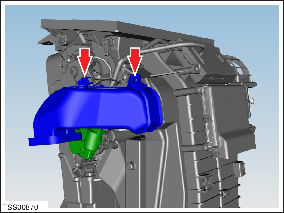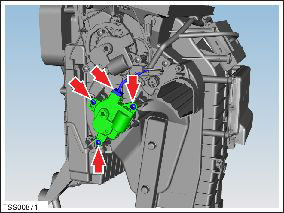Tesla Model S: Actuator - Driver's Temperature (Remove and Replace)
Tesla Model S (2012-2025) Service Manual / Thermal Management / Actuator - Driver's Temperature (Remove and Replace)
Removal
- Remove IP carrier (refer to procedure)
- Disconnect duct temperature sensor harness connector.
- Remove screw securing duct to HVAC assembly and position duct
aside (torque 1 Nm).

- Disconnect actuator harness connector.
- Remove screws (x3) securing driver's footwell actuator to HVAC assembly (torque 1 Nm).
- Remove driver temperature door flap actuator.
Caution: Take care not to damage component(s).

Installation procedure is the reverse of removal.
READ NEXT:
 Actuator - Mode (Remove and Replace)
Actuator - Mode (Remove and Replace)
Removal
Remove IP carrier (refer to procedure)
Disconnect duct temperature sensor harness connector.
Remove screw securing duct to HVAC assembly and position duct
aside (torque 1
 Actuator - Front Passenger's Temperature (Remove and Replace)
Actuator - Front Passenger's Temperature (Remove and Replace)
Removal
Remove glove box assembly (refer to procedure)
Disconnect duct temperature sensor harness connector.
Remove screw securing duct to HVAC assembly, release from spigot
and p
 Actuator - Defrost (Remove and Replace)
Actuator - Defrost (Remove and Replace)
Removal
Remove glove box assembly (refer to procedure)
Disconnect actuator harness connector.
Remove screws (x3) securing defrost door actuator to HVAC
assembly (torque 1 Nm).
SEE MORE:
 Rocker Panel - LH (Remove and Replace)
Rocker Panel - LH (Remove and Replace)
Removal
Remove the plastic rivets (x2) that secure the trailing edge of
the front wheel arch liner to the rocker panel finisher.
Remove the plastic rivets (x4) that secure the leading edge of
the rear wheel arch lin
 Glove Box (Remove and Replace)
Glove Box (Remove and Replace)
Removal
Remove the RH lower instrument panel (refer to procedure)
Remove the lower glove box panel by releasing the trim clips
(x6).
Open the glove box.
Remove the 6 screws that secure the glove box.
© 2019-2025 Copyright www.tesms.org

